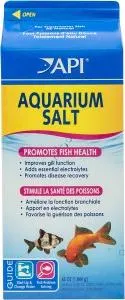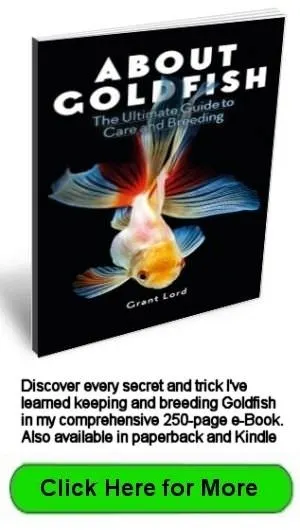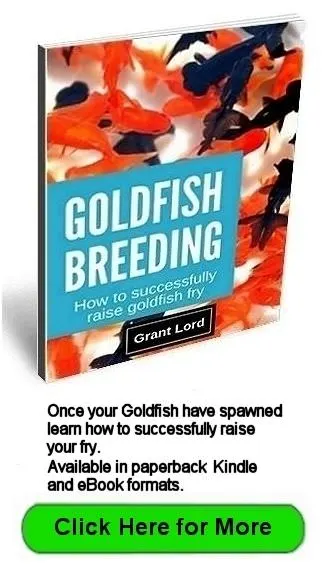- Home
- General Care
- How to Choose Goldfish
How To Choose Goldfish
Most failures with Goldfish start from the moment they are purchased.
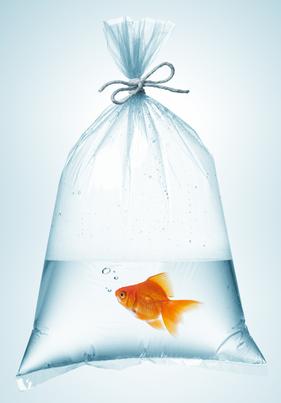 Goldfish correctly packaged for transporting home
Goldfish correctly packaged for transporting homeHow to choose Goldfish that are healthy, show the correct traits or characteristics for their type, and would make good breeders comes with experience.
To help you get started, we discuss here health checks, what varieties can be kept together, and getting your goldfish home and into the quarantine container safely.
How To Choose Goldfish That Are Compatible
All goldfish are not created equal. Don’t mix goldfish with large differences in size or traits. By this I mean if you mix a Black Moor Goldfish that has two caudal fins, a bulbous body and poor eyesight with Comet goldfish that have single tails, slim bodies and good eyesight, IT WILL STARVE.
As a general rule:
- Keep single caudal varieties with single caudal
- Twin caudal with twin caudal and
- Varieties with poor eyesight (Moors, Celestials, Water Bubble Eyes) by themselves.
Pre-purchase Health Checks
Before you hand over any money for your Goldfish make sure the specimen appears healthy. It may still have picked up a disease, but if it isn’t showing any signs yet, you will more than likely stop the disease from becoming serious during the quarantine period.
Stand back from the aquarium the Goldfish is in and observe the following:
- Is the fish active and looking for food? It shouldn’t be sitting on the bottom.
- Are all the fins present, un-frayed at the edges and being held erect and away from the body?
- Are there any red patches on the fins or body? (Hard to see on red or orange colored fish)
- Are there any white cotton wool like patches or pinhead size white spots anywhere on the fish?
- Is the body full and rounded? (Consider the goldfish type you are purchasing. A healthy Comet will be a lot slimmer than a sick Fantail, but the body should still be rounded and smooth, not appearing wasted).
- Is the Goldfish breathing normally, not fast compared to other fish in the aquarium?
- Does the fish’s movement appear effortless or is it labored as if it is struggling to keep buoyant?
- Few if any scales should be missing, and they shouldn't be extended like a pine cone (unless the goldfish is a Pearl Scale).
- Is the fish twitching or scratching against the gravel or aquarium sides?
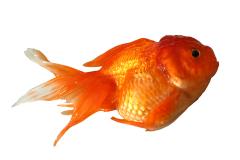 Goldfish showing signs of illness.
Goldfish showing signs of illness.How to choose Goldfish that are healthy is a skill quickly learned. With a little experience, a quick glance is all that is needed.
If you look at the Goldfish on this page, he isn't a happy fish. His fins are being held tightly against his body, one of the first signs of a sick fish. Whatever the problem is he hasn't lost a lot of weight so the problem is probably in the early stages.
If I particularly liked a sick fish, I would still buy it knowing there was a problem. If it had lost a lot of body weight, I wouldn't take the chance unless I got it for free.
If your Goldfish passes these health checks, the next step is to look for any serious faults for the variety you want to buy such as:
- Are two caudal fins present (all fancy goldfish have two caudal fins)? Look for twisted or bent fins.
- If the variety has no dorsal, is the back reasonably smooth with no spikes or a sail?
- Is each eye development the same if the variety is a Moor, Water Bubble Eye or Celestial?
How to choose Goldfish that show breeding potential is a little more difficult. This skill does take time to develop and even top breeders will have different opinions.
Getting Your Goldfish Home Safely
Your goal here is to maintain the temperature of the water your Goldfish is in now. Goldfish are poikilothermic. That means they are at the temperature of the water they are in. Unless the journey home is a short one, the plastic bag should be put into a container with thermal insulation properties, (Eskey, chilly bin or something similar).
If the car has air conditioning, even better. Sudden changes in water temperature WILL stress the Goldfish leading to death or disease.
Always Quarantine New Arrivals
Most Goldfish have been raised in large outdoor ponds with plenty of room. They are then caught, packed into small overcrowded aquariums with less than ideal water quality.
Assume your new arrival has caught some disease due to stress or is a carrier of a disease.
Your new arrival should be quarantined in a separate container with a small amount of medication added for two weeks at least before it can be considered clear of disease. Aquarium salt is good for this at a 0.3% concentration (3 grams per liter or 1 tablespoon per gallon). Goldfish are very tolerant of salt in their water.
Methylene Blue should be added if there is any scale or fin damage to stop fungal or bacterial attack.
API Stress Coat® which contains Aloe Vera re-coats fish with a protective layer while their natural slime coating regenerates. I recommended using it whenever fish are handled.
Treat for flukes and protozoan parasites using a Praziquantel based medication.
Introducing Your Goldfish To Its New Home
I have already mentioned the three water conditions that must be checked before moving Goldfish from one container to another on the Goldfish Care page:
- Water chemicals
- Water temperatures
- Water pH
Assuming you have made these checks, and the water the Goldfish are going into is suitable, there is a correct way to introduce your Goldfish to their temporary quarantine container.
The Correct Way To Introduce New Arrivals
Float the plastic bag in the quarantine aquarium.
If the plastic bag had pure oxygen added at the fish shop leave the bag closed. If not, open the bag.
Be aware that some single tailed Goldfish like to jump in stressful situations.
Watch for any signs of stress such as gasping at the surface. Aerate the water with an air stone at the first sign of gasping.
After half an hour or when the temperatures are the same, slowly start mixing the water in their bag with the aquarium water over an hour or so to equalize the pH. (If the pH is higher in the quarantine aquarium than in the bag, this process may be sped up).
Only after you have equalized the pH, gently tilt the plastic bag and let the fish swim into the quarantine aquarium or container.
You now know how to choose Goldfish by careful observation, that appear healthy and are showing the correct characteristics for their type.
The new arrivals now need to be quarantined for at least the next two to four weeks before introducing them into their new home.
Top of How To Choose Goldfish page
